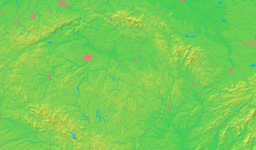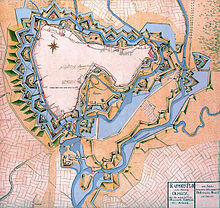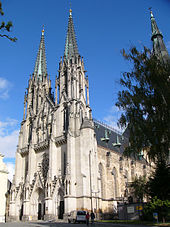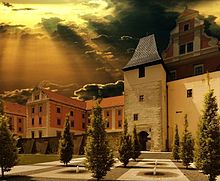- Olomouc
-
Olomouc City Olomouc panorama from Church of Saint MauriceFlagCoat of armsCountry Czech Republic Region Olomouc District Olomouc River Morava Elevation 219 m (719 ft) Coordinates 49°35′38″N 17°15′3″E / 49.59389°N 17.25083°E Area 103.36 km2 (39.91 sq mi) Population 102,004 (15 October 2010) [1] Density 987 / km2 (2,556 / sq mi) Founded 10th century - First mentioned 1017 Mayor Martin Novotný Postal code 779 00 UNESCO World Heritage Site Name Holy Trinity Column in Olomouc Year 2000 (#24) Number 859 Region Europe and North America Criteria i, iv Wikimedia Commons: Olomouc Website: http://www.olomoucko.cz/ Olomouc (Czech pronunciation: [ˈolomou̯ts]; local Haná dialect Olomóc or Holomóc, German Olmütz or Ollmütz, Polish Ołomuniec, Latin Eburum or Olomucium) is a city in Moravia, in the east of the Czech Republic. The city is located on the Morava river and is the ecclesiastical metropolis and historical capital city of Moravia. Nowadays, it is an administrative centre of the Olomouc Region and sixth largest city in the Czech Republic. The city has about 102 thousand residents, but its larger urban zone has a population of about 480 thousand people.[citation needed]
Contents
History
Olomouc is said to occupy a site of a Roman fort founded in the imperial period, the original name of which, Mons Julii, would have been gradually corrupted to the present form. Though this is just a legend, archaeological excavations revealed remains of a Roman military camp from the time of the Marcoman Wars close to the city.
During the 6th century the Slavs came to the area. As early as the 7th century, there was a centre of political power in the present-day quarter of Povel (situated in lowland, southerly from the city centre). Around 810 local Slavonic ruler was defeated by troops of Great Moravian rulers and settlement in Olomouc-Povel was destroyed. New centre, where the Great Moravian governor resided, was transferred to the gord at Předhradí, a quarter of the inner city (the eastern, smaller part of the medieval centre). This settlement thanks to its geographical location has survived extinction of the Great Moravia (c. 907) and later gradually became the capital of the province of Moravia. In 906 the first Jews settled in Olomouc.[citation needed] In 1060 they were forced into a ghetto and instructed to wear a yellow badge.[citation needed] The bishopric of Olomouc was founded in 1063;[2] centuries later raised to the rank of an archbishopric in 1777. The bishopric was moved from the church of St. Peter (now non-existent) to the church of St Wenceslas in 1141 (the date is still disputed, other suggestions are 1131, 1134) under bishop Henry Zdík and the bishop's palace was built in the Romanesque architectural style. The bishopric acquired large tracts of land, especially in northern Moravia, and was one of the richest in the area.
Olomouc became one of the most important settlements in Moravia and a seat of the Přemyslid government, seat of one of the appanage princes. In 1306 King Wenceslas III stopped here on his way to Poland, where he wanted to fight Wladislaus I the Elbow-high to claim his rights to the Polish crown, and was assassinated. With his death the whole Přemyslid dynasty died out.
The city itself was founded in the mid-thirteenth century and became one of the most important trade and power centres in the region. In the Middle Ages it was the biggest town in Moravia and competed with Brno for the position of the capital. Olomouc lost finally after the Swedes took the city for eight years (1642–1650).
In 1454 the Jews of Olomouc were expelled. Later in the second half of the fifteenth century is what can be viewed as the start of Olomouc's golden age. It hosted several royal meetings and Matthias Corvinus was elected here as King of Bohemia (in fact antiking) by the estates in 1469. In 1479 two kings of Bohemia (Vladislaus II and Matthias Corvinus) met here and concluded an agreement (Peace of Olomouc of 1479) for splitting the country.
During the Thirty Years' War, in 1640, Olomouc was occupied by the Swedes for eight years. They left the city in ruins and so it ceded its position to Brno. In 1740 the town was captured and briefly held by the Prussians. Olomouc was then fortified by Maria Theresa during the wars with Frederick the Great, who besieged the city unsuccessfully for seven weeks in 1758. In 1848 Olomouc was the scene of the emperor Ferdinand's abdication, and in 1850 an important conference between Austrian and German statesmen called the Punctation of Olmütz took place here. At the conference, the German Confederation was restored and Prussia submitted its leadership to the Austrians.
In 1746 the first learned society in the lands under control of the Austrian Habsburgs, the Societas eruditorum incognitorum in terris Austriacis, was founded in Olomouc in order to spread Enlightenment ideas. Its monthly journal Monatliche Auszüge was the first scientific journal in the Habsburg Monarchy.
Largely because of its ecclesiastical links to Austria, Salzburg in particular, the city has had a German influence since the Middle Ages. It is difficult assess the ethnic makeup of the town before an accurate census was taken. However, official documents from the second half of the 16th century and early 17th century reveal that the town's ecclesiastical constitution, the meetings of the Diet and the locally printed hymnal, were all in the Czech language. Also, the first treatise on music in the Czech language was published in Olomouc in the mid 16th century. The political and social changes that followed the Thirty Years War increased the influence of courtly Habsburg culture. The "Germanification" of the town was probably more a result of the cosmopolitan environment of the town than by design. As the cultural, administrative and religious centre of the region, it drew officials, musicians and traders from all over Europe. Despite these influences, the Czech language still persisted, particularly in ecclesiastical publications throughout the seventeenth and eighteenth centuries. When the Austrian-born composer and musician Philip J. Rittler accepted a post at the Wenceslas Cathedral in the second half of the seventeenth century, he still felt it necessary to learn Czech. However, the use of the Czech language in official matters went into decline and by the 19th century, the official statistics record that the number of Germans was three times higher than the number of Czechs.[3] After the revolution in 1848, the Jewish expulsion order of 1454 was rescinded. In 1897 a synagogue was built and the Jewish population reached 1,676 in 1900. Olomouc was enclosed with city walls almost until the end of the 19th century. This suited the city council, because demolishing the walls would allow for extension of the city, which would result in the settlement of many Czechs from neighbouring villages. The city council preferred Olomouc smaller, but German. Expansion came after WWI and the establishment of Czechoslovakia, when Olomouc integrated two neighbouring towns and 11 surrounding villages and thus gained new space for its growth.
There were serious tensions between the Czech and German-speaking inhabitants during both world wars (largely brought on by outside provocation). On Kristallnacht (10 November 1938), the synagogue was destroyed and in March 1939, 800 Jewish men were arrested, some being sent to Dachau concentration camp. During 1942–1943, the remaining Jews were sent to Theresienstadt and other German concentration camps in occupied Poland. 285 of the town's Jews survived the Holocaust. During the war most of the town's German residents sided with the Nazis and the German-run town council renamed the main square after Adolf Hitler. The Czech residents changed the name again after the town was liberated. When the retreating German army passed through Olomouc in the final weeks of the war they opened fire on the town's old astronomical clock, leaving only a few pieces (that can now be seen in the local museum). The one that can be seen today is a 1950s reconstruction and features a procession of proletarians rather than saints. Most of the German population was expelled after the war.
Despite its considerable charms, Olomouc has not been discovered by tourists in the same way that Prague, Český Krumlov and Karlovy Vary have. Its inner city is the second-largest historical monuments preserve in the country, after Prague.
One of Olomouc's famous sons was the film-maker Edgar G. Ulmer, who was born in Olomouc in 1904, but who always preferred to give Vienna as his birthplace, as this sounded less provincial.[4] Another notable son of Olomouc is football coach Karel Brückner, formerly head coach of the Czech national team and later head coach of Austria.
City monuments
Olomouc contains several large squares, the chief of which is adorned with the Holy Trinity Column, a UNESCO World Heritage Site. The column is 115 ft (35 m) high and was built between 1716 and 1754. The city is characterized by a large number of religious buildings. The most prominent church is Saint Wenceslas cathedral founded before 1107 in the compound of the Olomouc Castle. At the end of the 19th century the Cathedral was rebuilt in the neo-Gothic style, but it kept many features of the original church, which had been rebuilt many times (Romanesque crypt, Gothic cloister, Baroque chapels). The highest of its three spires is 328 ft (100 m), which makes it the second highest spire in the country (after Cathedral of St. Bartholomew in Plzeň). The church is just next to the Bishop Zdík's Palace (also called the Přemyslid Palace), a Romanesque building built after 1141 by the bishop Henry Zdík. Remnants of it are one of the most precious monuments of Olomouc: a bishop's palace, a secular building of that early age is unique in Central Europe. The real Přemyslid Palace, i.e. the residence of Olomouc dukes from the governing Přemyslid dynasty, used to stand nearby.
Saint Maurice Church, a fine Gothic building of the 15th century with the 6th largest church organ in Central Europe inside and Saint Michael's Church are also worth mentioning. The Neo-baroque chapel of Saint John Sarkander stands on the site of a former town prison. Catholic priest John Sarkander was imprisoned here at the beginning of the Thirty Years' War. He was accused of collaboration with the enemy and tortured here, but did not reveal anything because of the Seal of Confession, and died. The torture rack and Sarkander’s gravestone are preserved here. He was canonized by Pope John Paul II during his visit in Olomouc in 1995. Another place that John Paul II visited here was Svatý Kopeček ("The Holy Hillock"), a part of Olomouc lying on a hill, with the magnificent Baroque church of the Visitation of the Virgin Mary looking down on the city. The Pope promoted the church to Minor Basilica. There are a number of monasteries in Olomouc, including Hradisko Monastery, Convent of Dominican Sisters in Olomouc and others.
Remarkable sights are also the Olomouc Orthodox Church consecrated to St. Gorazd or Mausoleum of Yugoslav Soldiers, a monument, commemorating the death of 1,188 Yugoslav soldiers which were wounded on battlefields of the World War I and died in local military hospitals.
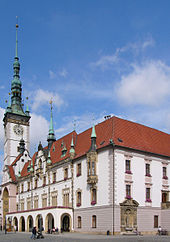 Town hall with astronomical clock
Town hall with astronomical clock
The principal secular building is the town hall, completed in the 15th century, flanked on one side by a gothic chapel, transformed now into a museum. It possesses a tower 250 ft (76 m) high, adorned with an astronomical clock in an uncommon Socialist Realist style (the original look from 15th century was destroyed at the end of the World War II and reconstructed in 1947–1955 by Karel Svolinský).
Olomouc is also proud of its six Baroque fountains. The fountains survived in such number thanks to the cautious policy of the city council. While most European cities were removing old fountains after they had built their water supply piping, Olomouc decided to keep them as water reservoirs in case of fire. For their decoration, ancient Roman motifs were used. Five of them depict the Roman gods Jupiter (image), Mercury (image), Triton (image), Neptune and Hercules (image), and one depicts Julius Caesar, the legendary founder of the city (image). In the 21st century, an Arion fountain was added to the main square, inspired by the older project.
In the largest square in Olomouc (Horní náměstí - Upper Square), in front of the astronomical clock, is a scale model of the entire old town in bronze.
University
Main article: Palacký University, OlomoucThe university, the oldest in Moravia and second oldest in the Czech Republic, was founded in 1573 as part of effort to reestablish Roman Catholicism in the country: roughly nine out of ten[5] inhabitants of the Czech Crown lands were Protestants at the time. Most of its faculties were suppressed in 1850s by the Habsburg régime in retaliation for the professors' and students' support for the 1848 revolution and the Czech National Revival. The university was fully restored in 1946 with its name extended to Palacký University of Olomouc.
The Palacký University of Olomouc plays a very important role in the life of the town: with over 25,200 students (including those at Moravian College Olomouc) Olomouc has the highest density of university students in Central Europe. Many of the town's services are student-oriented and close not only during holidays, but also during the university exam periods. During the summer holiday even the trams run solo (apart from rush-hours), while during the rest of the year the lines are served by two coupled trams. The University buildings comprise about a third of the town's heritage centre; notable ones include the University Art Centre and the so-called Armoury (now Central Library).
Mayors
List of Olomouc mayors:[6]
- 1851–1865 Franz Kreilm
- 1865–1866 Franz Hein
- 1866–1872 Dr. Karl Borom. Johann Nep. Alois Schrötter
- 1872–1896 Josef von Engel
- 1896–1918 Karl Brandhuber
- 1918–1919 government commissioner
- 1919–1923 Dr. Karel Mareš
- 1923–1939 Dr. Richard Fischer
- 1939–1941 Dr. Fritz Czermak
- 1942–1945 Dr. Julius Schreitter
- 1945–1947 Václav Stibor-Kladenský
- 1947–1949 Jan Kučera
- 1949–1950 Ladislav Bernatský
- 1950–1956 Antonín Eliáš
- 1957–1960 Josef Drmola
- 1960–1970 František Řeháček
- 1970–1986 Dr. Jan Tencian
- 1986–1989 Ing. Josef Votoček
- 1989–1990 Břetislav Baran
- 1990–1994 Milan Hořínek PhD.
- 1994–1998 RNDr. Ivan Kosatík
- 1998–2006 Ing. Martin Tesařík
- 2006– Martin Novotný
Sport
- SK Sigma Olomouc – football club
- HC Olomouc – hockey club
- Skokani Olomouc – baseball club
- 1. HFK Olomouc – football club
- DHK Olomouc – women's handball club
- AK Olomouc – athletics club
- RC Olomouc – rugby club
International relations
See also: List of twin towns and sister cities in the Czech RepublicTwin towns – Sister cities
Olomouc is twinned with:
 Antony, Hauts-de-Seine, France
Antony, Hauts-de-Seine, France Lucerne, Switzerland
Lucerne, Switzerland Nördlingen, Germany
Nördlingen, Germany
 Tampere, Finland
Tampere, Finland Veenendaal, Netherlands
Veenendaal, Netherlands Volzhskiy, Russia
Volzhskiy, Russia
In popular culture
- Asteroid 30564 Olomouc was named after this city.
- Scenes from the 2002 television serial Doctor Zhivago were filmed in Olomouc.
See also
- Academia Film Olomouc
- List of bishops and archbishops of Olomouc
- Olomouc Appanage
Footnotes
- ^ "Adresy v České republice: Olomouc" (in Czech). Ministry of the Interior of the Czech Republic. http://aplikace.mvcr.cz/adresa/m/olomo/index.html. Retrieved 6 August 2010.
- ^ Possibly re-founded because there are some unclear references to bishops of Moravia in the 10th century – if they were not only missionary bishops, but representatives of some remains of regular church organization, then it is very likely that these bishops had seat right here
- ^ Tichák, Milan (1997). Vzpomínky na starou Olomouc. Olomouc: Votobia. p. 13. ISBN 80-7198-184-2.
- ^ Last year, after research in various archives, Bernd Herzogenrath located the address where Ulmer was born in Olomouc. In 1904, the address was known as “Resselgasse 1, Ort Neugasse.” Today, the name is Resslova 1. A memorial plaque, designed by artist Bohumil Teplý, commemorating Ulmer's birth home was unveiled on Sept 17, 2006, on the occasion of the Ulmerfest 2006 – the First Academic Conference devoted to Ulmer's work. His daughter Arianné Ulmer-Cipes and her family were present at the event.
- ^ Václavík, David (2010). Náboženství a moderní česká společnost. Grada Publishing a.s.. http://books.google.com/books?id=1A5P3H2gT0sC&lpg=PA2&dq=N%C3%A1bo%C5%BEenstv%C3%AD%20a%20modern%C3%AD%20%C4%8Desk%C3%A1%20spole%C4%8Dnost&hl=cs&pg=PA53#v=onepage&q&f=false.
- ^ cz:Olomouc
External links
- Municipal website
- Portal Olomouc
- Olomouc – Czech.cz, official portal of the Czech Republic
- Olomouc travel guide from Wikitravel
- UNESCO World Heritage Site: Holy Trinity Column
- Palacký University
- Moravian college
- Filmmaker Albert Maysles in Olomouc
Webcams
- Olomouc town hall with an astronomical clock
- Horní náměstí (Upper Square) with the Holy Trinity Column
Tourism
- Official portal for tourist – information, services, leisure time, monuments, culture
- Olomouc-travel.cz
Towns, market towns and villages of Olomouc District Babice · Bělkovice-Lašťany · Bílá Lhota · Bílsko · Blatec · Bohuňovice · Bouzov · Bukovany · Bystročice · Bystrovany · Červenka · Charváty · Cholina · Daskabát · Dlouhá Loučka · Dolany · Doloplazy · Domašov nad Bystřicí · Domašov u Šternberka · Drahanovice · Dub nad Moravou · Dubčany · Grygov · Haňovice · Hlásnice · Hlubočky · Hlušovice · Hněvotín · Hnojice · Horka nad Moravou · Horní Loděnice · Hraničné Petrovice · Huzová · Jívová · Komárov · Kožušany-Tážaly · Krčmaň · Křelov-Břuchotín · Liboš · Lipina · Lipinka · Litovel · Loučany · Loučka · Luběnice · Luká · Lutín · Lužice · Majetín · Medlov · Měrotín · Mladeč · Mladějovice · Moravský Beroun · Mrsklesy · Mutkov · Náklo · Náměšť na Hané · Norberčany · Nová Hradečná · Olbramice · Olomouc · Paseka · Pňovice · Přáslavice · Příkazy · Řídeč · Samotišky · Senice na Hané · Senička · Skrbeň · Slatinice · Slavětín · Štarnov · Štěpánov · Šternberk · Strukov · Střeň · Suchonice · Šumvald · Svésedlice · Těšetice · Tovéř · Troubelice · Tršice · Újezd · Uničov · Ústín · Velká Bystřice · Velký Týnec · Velký Újezd · Věrovany · Vilémov · Želechovice · ŽerotínAdministrative seats of Czech regions  Brno • České Budějovice • Hradec Králové • Jihlava • Karlovy Vary • Liberec • Ostrava • Olomouc • Pardubice • Plzeň • Prague • Ústí nad Labem • Zlín
Brno • České Budějovice • Hradec Králové • Jihlava • Karlovy Vary • Liberec • Ostrava • Olomouc • Pardubice • Plzeň • Prague • Ústí nad Labem • Zlín Categories:
Categories:
Wikimedia Foundation. 2010.




